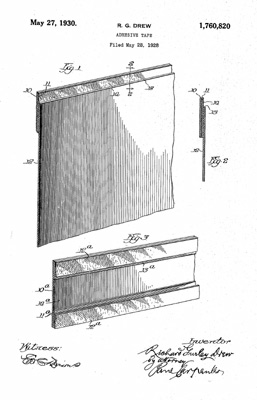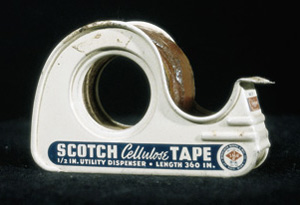 Can you imagine life without tape? How would we wrap presents, fix ripped papers and make duct tape dresses? Richard Drew invented the first masking tape in 1925.
Can you imagine life without tape? How would we wrap presents, fix ripped papers and make duct tape dresses? Richard Drew invented the first masking tape in 1925.
Richard Drew was an engineer working at 3M when he perfected the masking tape. At the time, 3M was a sandpaper manufacturer. Drew was delivering trial batches of sandpaper to a local auto shop when he learned how difficult it was to do the two-tone paint jobs that were very popular in cars during the 1920s. Painting a perfect border between the two colors was nearly impossible. When removing the butcher paper on the cars, some of the painted that was just applied would peel off. Touching up the damaged paint increased the time and cost of the paint job.
Drew worked for two years in the lab at 3M to invent the first masking tape which was a two-inch wide tan paper strip backed with light adhesive. It was originally made from cabinetmaker’s glue and treated crepe paper. The first run only had adhesive on the sides and not the middle.
The first trial of this new tape was a complete failure. The tape fell off the car because it did not have enough adhesive. A very frustrated painter yelled at Drew about this new product saying “Take this tape back to those Scotch bosses of yours and tell them to put more adhesive on it!” (By Scotch he meant parsimonious or stingy.) Even after Drew improved the masking tape and added more adhesive the name Scotch stuck. His new tape was called Scotch Brand Cellulose Tape.
 Richard Drew applied for a patent for his new invention on May 28, 1928. He was granted patent #1,760,820 on May 27, 1930 for Adhesive Tape.
Richard Drew applied for a patent for his new invention on May 28, 1928. He was granted patent #1,760,820 on May 27, 1930 for Adhesive Tape.
Drew also invented the first transparent tape by applying a nearly invisible adhesive of rubber, oil and resins to a cellophane backing. It was both waterproof and able to withstand a range of temperatures and humidity.
While it had originally been designed to seal food wrappers, this new tape came into its own as a “fix-all” solution during the Great Depression. At a time when people were forced to be much more frugal, they began using tape to fix things at home. It was used to mend clothes, seal packages and even fixed ripped money – all tasks we complete with the help of tape even to this day.
